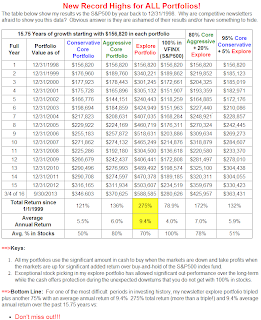Social Security Announces 1.5 Percent Benefit Increase for 2014
For those of us still working, the maximum amount of earnings subject to the Social Security tax (taxable maximum) will increase 2.9% to $117,000 from $113,700.
From the official website:
Monthly Social Security and Supplemental Security Income (SSI) benefits for nearly 63 million Americans will increase 1.5 percent in 2014, the Social Security Administration announced today.
The 1.5 percent cost-of-living adjustment (COLA) will begin with benefits that more than 57 million Social Security beneficiaries receive in January 2014. Increased payments to more than 8 million SSI beneficiaries will begin on December 31, 2013.
Some other changes that take effect in January of each year are based on the increase in average wages. Based on that increase, the maximum amount of earnings subject to the Social Security tax (taxable maximum) will increase to $117,000 from $113,700. Of the estimated 165 million workers who will pay Social Security taxes in 2014, about 10 million will pay higher taxes as a result of the increase in the taxable maximum.
Information about Medicare changes for 2014 is available at www.Medicare.gov.
The Social Security Act provides for how the COLA is calculated. To read more, please visit www.socialsecurity.gov/cola.
How is a COLA calculated? [From Latest Cost-Of-Living Adjustment]
The Social Security Act specifies a formula for determining each COLA. According to the formula, COLAs are based on increases in the Consumer Price Index for Urban Wage Earners and Clerical Workers (CPI-W). CPI-Ws are calculated on a monthly basis by the Bureau of Labor Statistics.
A COLA effective for December of the current year is equal to the percentage increase (if any) in the average CPI-W for the third quarter of the current year over the average for the third quarter of the last year in which a COLA became effective. If there is an increase, it must be rounded to the nearest tenth of one percent. If there is no increase, or if the rounded increase is zero, there is no COLA.
COLA Computation
The last year in which a COLA became effective was 2012. Therefore the law requires that we use the average CPI-W for the third quarter of 2012 as the base from which we measure the increase (if any) in the average CPI-W. The base average is 226.936, as shown in the table below.
The last year in which a COLA became effective was 2012. Therefore the law requires that we use the average CPI-W for the third quarter of 2012 as the base from which we measure the increase (if any) in the average CPI-W. The base average is 226.936, as shown in the table below.
Also shown in the table below, the average CPI-W for the third quarter of 2013 is 230.327. Because this average exceeds 226.936 by 1.5 percent, the COLA effective for December 2013 is 1.5 percent. The COLA calculation, with the result rounded to the nearest one-tenth of one percent, is:
| CPI-W for— | ||
|---|---|---|
| 2012 | 2013 | |
| July | 225.568 | 230.084 |
| August | 227.056 | 230.359 |
| September | 228.184 | 230.537 |
| Third quarter total | 680.808 | 690.980 |
| Average (rounded to the nearest 0.001) | 226.936 | 230.327 |
Table of Social Security COLAs by Year
-
"Kirk Lindstrom's Investment Letter"
"Kirk Lindstrom's Investment Letter"








